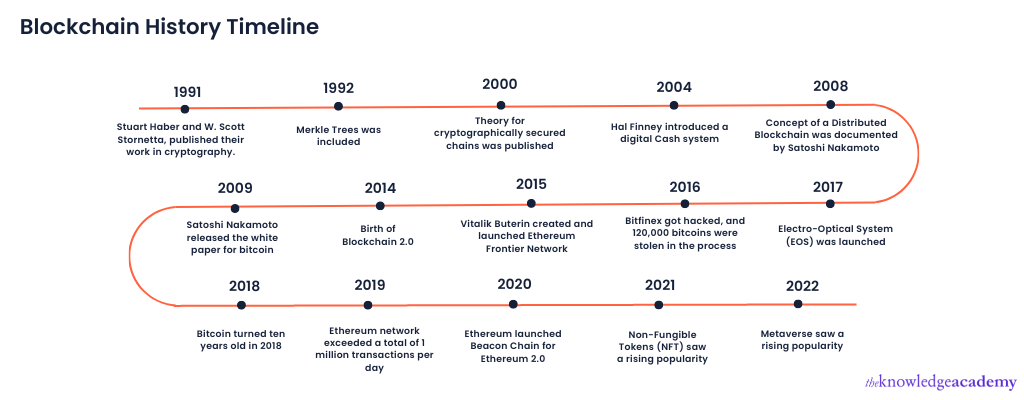We may not have the course you’re looking for. If you enquire or give us a call on +1 6474932992 and speak to our training experts, we may still be able to help with your training requirements.
Training Outcomes Within Your Budget!
We ensure quality, budget-alignment, and timely delivery by our expert instructors.

One of the most significant game-changing evolution of the 21st century, Blockchain Technology has had a massive impact on almost every industry today. Even though Blockchain gained popularity just a few years back, its history dates back to the 1990s.
According to Economic Times, Blockchain can help financial institutions save up to £10 billion annually. This is no ordinary feat, and to get here, Blockchain technology had to go through over three decades of evolution. This blog will take you through a brief history of Blockchain Technology.
Table of Contents
1) Let’s discuss the blockchain history timeline
a) 1991
b) 1992
c) 2000
d) 2004
e) 2008
f) 2009
g) 2014
h) 2015
i) 2016
j) 2017
k) 2018
l) 2019
m) 2020
n) 2021
o) 2022
2) The Future of Blockchain
3) Conclusion
Learn in-depth about Blockchain technology in our Blockchain Training Course!
Let’s discuss the blockchain history timeline

Blockchain has grown into a technological and financial giant alike. Such success for cryptocurrency and Blockchain did not come for granted, as it went through many years of growth before reaching the current stage. Let's discuss the evolution of Blockchain over the years.
1991
In 1991, two scientists, Stuart Haber and W. Scott Stornetta, published their work in cryptography. Their work included a chain of blocks secured using cryptography so the content and its date couldn't be tampered with. This system later became known as Blockchain Technology, referring to the chain of blocks, where each block stored vital information.
1992
The system was further upgraded in 1992 when Merkle Trees was included to make it more efficient. This made adding multiple documents on one block in a Blockchain possible. Unfortunately, this technology reached a cease in 2004 due to a patent.
2000
Stefan Konst published his theory for cryptographically secured chains and their implementation in the year 2000.
Refer to these Blockchain Interview Questions and Answers to crack your next job interview!
2004
Hal Finney introduced a digital Cash system in the year 2004. This system was referred to as a Reusable proof of work, and it solved the critical issue of double spending by registering the ownership of tokens.
2008
Satoshi Nakamoto modified Merkle Tree’s model in 2008, leading to a more secure system containing a history of data exchange. This concept of a Distributed Blockchain was documented in his white paper “a peer-to-peer electronic cash system”. This peer-to-peer network of time stamps led to Blockchain becoming the backbone of cryptography.
2009
Satoshi Nakamoto released the white paper for bitcoin in the year 2009. Blockchain reached a new peak of security at this stage, as documented by an event in the UK in the year 2013.
James Howells, an IT worker in the UK, started mining bitcoins in 2009, spending over 14000 GBP until 2013. Once he was done mining bitcoins, he extracted his drive and sold the remaining parts of his laptop. Unfortunately, he tossed his hard drive away with garbage while cleaning his room in 2013. A few years pass, and while he has not been able to claim his bitcoins which rose to a value of more than 105 million GBP by 2017, no one else has been able to claim that money.
2014
Blockchain technology got separated from currency, leading to the birth of Blockchain 2.0 in the year 2014. This changed the focus of industries away from digital currency and its trajectory to the development of Blockchain technologies.
2015
Vitalik Buterin created and launched Ethereum Frontier Network with its other co-founders in 2015. Ethereum was another open-source Blockchain, which later reached the second highest market capitalisation, second only to Bitcoin. Ethereum came with smart contract functionality and the ability to deploy decentralised applications, allowing users to interact with them.
The Linux Foundation launched the Hyperledger project in the same year, where it started working on an open-source Blockchain. It was developed as an umbrella project, facilitating the collaborative development of distributed ledgers. Its fundamental goal is to enhance performance to help in global transactions.
2016
Blockchain was finally referred to as a single terminology rather than two different entities, growing further from how they were described in Satoshi Nakamoto's original Blockchain white paper.
In 2016, when Blockchain started seeing the face of mainstream popularity, the Decentralised Autonomous Organisation of Ethereum (DAO Ethereum) had its code exploited. This led to a difference in the principles of its stockholders, leading to a hard fork in Ethereum. Simultaneously a cryptocurrency exchange service known as Bitfinex got hacked, and 120,000 bitcoins were stolen in the process.
2017
Japan recognised Bitcoin as a legal form of payment method in the year 2017. In the same year, Block.one, a private company, launched Electro-Optical System (EOS) as a native cryptocurrency. EOS was different as it could behave like real computers. EOS.IO has been used as a decentralised operating system and facilitates the deployment of decentralised apps via autonomous decentralised corp.
2018
Bitcoin turned ten years old in 2018, seeing the mark of success; however, what followed was not as celebratory for Bitcoin. Online platforms soon started banning cryptocurrency advertisements, with Google, Facebook and Twitter following suit. At the end of 2018, Bitcoin’s value reached a significant low of 3157.23 GBP.
Want to know more about cryptocurrencies? Join our Bitcoin and Cryptocurrency course!
2019
Ethereum network exceeded a total of 1 million transactions per day in the year 2019. Soon Amazon announced Amazon Managed Blockchain service on its Amazon Web Services (AWS) Platform.
2020
Ethereum launched Beacon Chain in the year 2020 in preparation for Ethereum 2.0. Stablecoins also saw a rising popularity this year, as it was more stable than traditional cryptocurrencies.
2021
Non-Fungible Tokens (NFT) saw a rising popularity in the year 2021. NFT worked with a similar principle to cryptocurrency, where a digital asset held value or asset. These digital assets varied from videos to music records; however, they generally came in the form of digital art. These digital assets gave opportunities to artists of these digital assets and traders alike. NFT marketplaces like OpenSea became a common platform for such trades, making it a great year for digital assets-based trade.
The year 2021 saw a pandemic crisis, where Covid-19 led to a work-from-home culture. This work-from-home culture inspired the creation of the virtual world, allowing people to interact with each other virtually. Eventually, Virtual Reality (VR), Artificial Reality (AR) and Web3 reached an intersection, leading to the creation of Metaverse, where Mark Zuckerberg, the CEO of Facebook, eventually renamed his company “Meta”.
2021 was an eventful year for Blockchain, with the technology witnessing highs and lows. Bitcoin’s value saw an all-time high of 53884.68 GBP. Following this surge in value, Elon Musk jumped on the rising popularity of Bitcoin. He made a statement announcing Bitcoin as a valid payment method for purchasing Tesla cars, only to withdraw that statement later due to the environmental strain Bitcoin Mining caused.
Similarly, Bitcoin had varying sentiments across different nations and their government. Where El Salvador became the first nation to accept Bitcoin as a legal currency, India banned the usage of cryptocurrency as a payment. Irrelevant of how nations felt about cryptocurrencies, web3 was promoted worldwide.
2022
The year 2022 carried the previous popularity of NFTs, leading to more excellent opportunities for trading and earning with NFTs. It was further endorsed on the Metaverse by several corporate giants like Adidas, Puma, Nike, Walmart, Gucci and Ferrari. These companies created and promoted NFT designs based on their products for avatars on Metaverse.
However, NFTs were not taken positively everywhere, with India taxing digital assets at 30%. Blockchain and its uses continued getting explored and tested in various fields such as Blockchain in the Supply chain, Satellite communication using smart contracts, and other fields like Entertainment, Automation and Real-estate.
Secure your future with our Ethereum Developer Training course!
The Future of Blockchain
If one thing is highlighted in history, it's the future possibilities of blockchain technology. Governments are looking to implement Blockchain Technology to upgrade their security and privacy. There have been hints that soon, we might have a public Blockchain that anyone can use.
The technology might also facilitate innovation in the automation of tasks, making its way into search engines. The Blockchain industry is expected to be worth 107.21 billion GBP by 2029 at a compound growth rate of 56.3%. By 2030, the industry is predicted to grow at a compound annual growth rate of 85.9%.
Blockchain developers have spearheaded the evolution of Blockchain technology, and hence, it has created a massive demand for professionals.
Bitcoin's role
Satoshi Nakamoto created Bitcoin with the intent for it to be used as a form of cash with the benefits of peer-to-peer review. This form of payment didn’t need a central bank or other authorities to maintain or operate it the same way one has to do with physical cash. This led to the first-ever cryptocurrency and the successful implementation of Blockchain.
From the documentation of Bitcoin in a white paper in 2008 to the launch of its code in 2009, Satoshi Nakamoto played a crucial part in the development of Bitcoin. Satoshi’s creation, an engine to run the bitcoin ledger, was called the Blockchain. It was the original and the most prominent Blockchain still used to orchestrate Bitcoin transactions today.
Even after the creator of Bitcoin, Satoshi Nakamoto, disappeared, his creation, Bitcoin, and his wisdom contributed significantly to Blockchain Technology. Bitcoin and Blockchain technologies were passed to the newer generation of Developers and Scientists, where new use cases of Blockchain and discoveries are still being made.
Conclusion
If you were looking for the best time to learn about Blockchain, the time is now. The history of Blockchain has had many heroes who have constantly innovated the technology, dissatisfied by any limitations. Nobody knows exactly where it’ll go in the future. But we do know that it’s going to keep growing. Who knows, maybe, you’ll be next?
Get your kickstart into Blockchain technology! Check out our Blockchain training courses!
Frequently Asked Questions
Upcoming Programming & DevOps Resources Batches & Dates
Date
 Blockchain Training Course
Blockchain Training Course
Thu 15th Aug 2024
Thu 21st Nov 2024







 Top Rated Course
Top Rated Course




 If you wish to make any changes to your course, please
If you wish to make any changes to your course, please


